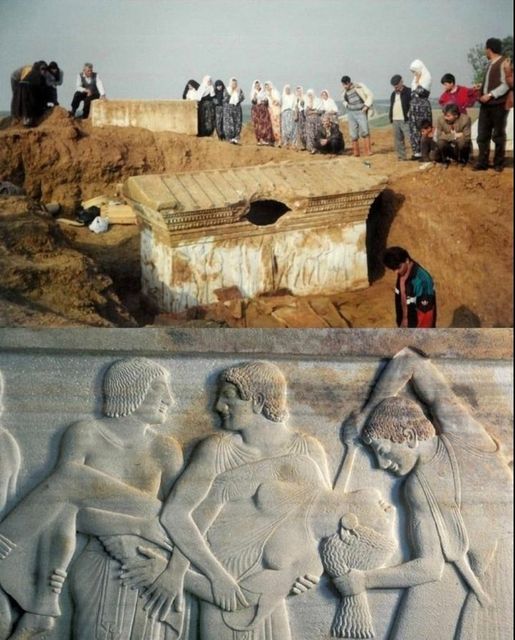In the summer of 1994, a groundbreaking archaeological discovery unfolded near the ancient city of Troy, in present-day Turkey. Led by Dr. Erhan Özdoğan, a seasoned archaeologist with decades of field experience, the excavation team unearthed a burial site hidden deep beneath layers of soil and time. What they found was nothing short of extraordinary—a beautifully preserved sarcophagus dating back 2,500 years. This stunning relic, later named the Polyxena Sarcophagus, would not only captivate scholars and history enthusiasts alike but also offer profound insights into the funerary customs, mythological significance, and cultural intersections of the ancient world.

Carved from fine white marble, the Polyxena Sarcophagus is a remarkable testament to ancient artistry and reverence for the dead. Its surface is adorned with intricate reliefs that depict scenes from the myth of Polyxena, the fabled Trojan princess who, according to legend, was sacrificed at the tomb of the Greek hero Achilles. These carved images are more than decorative; they convey the myth with such precision and emotion that they breathe life into a story passed down through generations. One side of the sarcophagus illustrates Polyxena’s abduction, while another shows the moment of her tragic sacrifice. Each figure carved into the marble displays a level of detail and expression that reveals not just technical mastery but also an intimate understanding of human emotion and storytelling.
The lid of the sarcophagus adds a deeply personal touch to this ancient monument. There, Polyxena is depicted lying in repose, her serene face and relaxed posture giving the impression of peaceful slumber. Her features are so finely sculpted, with an almost ethereal quality, that one can easily imagine the emotional impact this piece had on those who commissioned it. The choice to portray Polyxena in such a gentle, restful state suggests a desire to honor her not only as a mythological figure but also as a young woman whose life and death were deeply mourned.
Inside the sarcophagus, the team discovered the skeletal remains of a young woman, along with a carefully arranged collection of grave goods. These included elaborately crafted pottery, polished bronze mirrors, and delicate jewelry made from precious metals and stones. The presence of such luxurious items indicates that the woman had held a significant status in her community, possibly as a priestess or a member of the local aristocracy. Her burial in a sarcophagus of such artistic and cultural value suggests that her family was both affluent and influential, with the means to commission a monument that fused local traditions with broader mythological themes.
As the excavation continued, researchers began to piece together the likely history of the sarcophagus and the identity of the young woman within it. Evidence pointed to a family of mixed Greek and Trojan heritage—people who had embraced the blending of cultures following centuries of interaction and conflict in the region. By choosing to memorialize their daughter with scenes from Greek mythology, specifically a tale deeply connected to the Trojan legacy, they created a powerful symbol of unity and remembrance. The sarcophagus served not only as a final resting place but also as a bridge between two worlds, honoring both ancestral roots and the broader Hellenistic culture that had taken hold in the region.
The discovery of the Polyxena Sarcophagus also reignited public and academic interest in the myths surrounding the fall of Troy. For centuries, the story of Troy—its heroes, tragedies, and epic battles—had captivated imaginations, from the writings of Homer to modern interpretations. The sarcophagus brought one of those legendary tales into the tangible realm, allowing viewers to see and touch the legacy of Polyxena, whose story had long lived only in texts and oral traditions. This physical connection to the myth underscored the enduring power of storytelling in human history and its ability to preserve cultural identity across millennia.
After the initial excavation, the sarcophagus was transported with great care to a conservation facility, where it underwent meticulous study and preservation. Archaeologists, historians, and art experts collaborated to analyze its structure, artistic style, and historical context. Their findings revealed not only the sarcophagus’s exceptional craftsmanship but also its role in shedding light on the fusion of Greek and Anatolian traditions in the ancient world. The carvings, in their symbolism and detail, spoke to shared beliefs about death, honor, and remembrance, offering a nuanced understanding of the values held by ancient societies.
In time, the Polyxena Sarcophagus was placed on permanent display at the Troy Museum, where it quickly became one of the institution’s most celebrated artifacts. Visitors from around the globe came to witness the breathtaking beauty of its carvings and to learn about the rich history it represents. The sarcophagus does more than showcase ancient artistry—it serves as a portal into the past, inviting people to reflect on the universal themes of love, loss, and legacy. It demonstrates how myth and memory intertwine, shaping our understanding of those who came before us.
Today, the Polyxena Sarcophagus is recognized as one of the most significant archaeological finds of the late 20th century. Its discovery greatly expanded our knowledge of ancient funerary customs, especially in the context of cultural exchange and the lasting impact of mythology on real-world practices. It reminds us that even in death, individuals could be commemorated in ways that celebrated their lives while also reinforcing communal values and historical narratives.
As we continue to study and preserve such treasures, we deepen our connection to the ancient world and reaffirm the importance of archaeology in uncovering and understanding the human experience. The story of Polyxena—etched in marble and immortalized through art—continues to inspire awe, offering timeless insight into the beliefs, emotions, and creativity that define humanity across ages.





